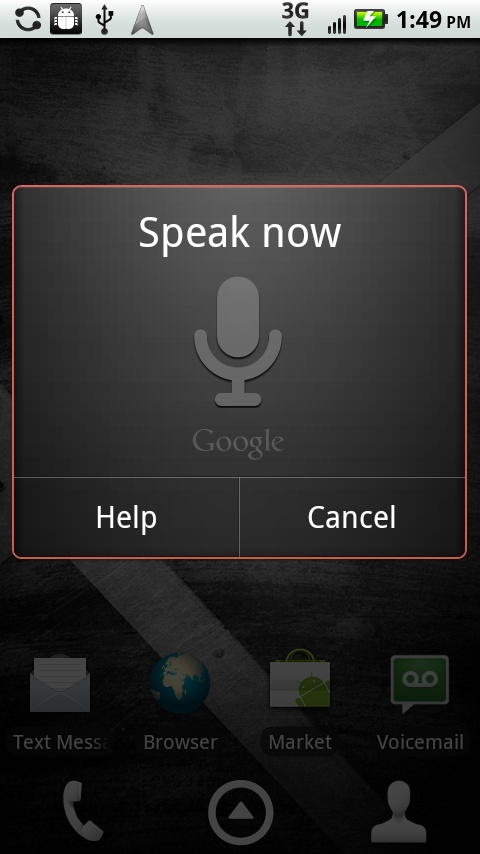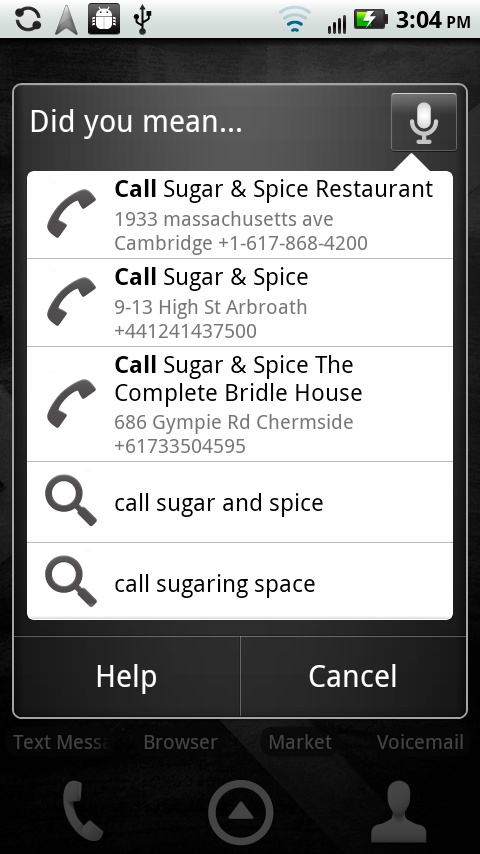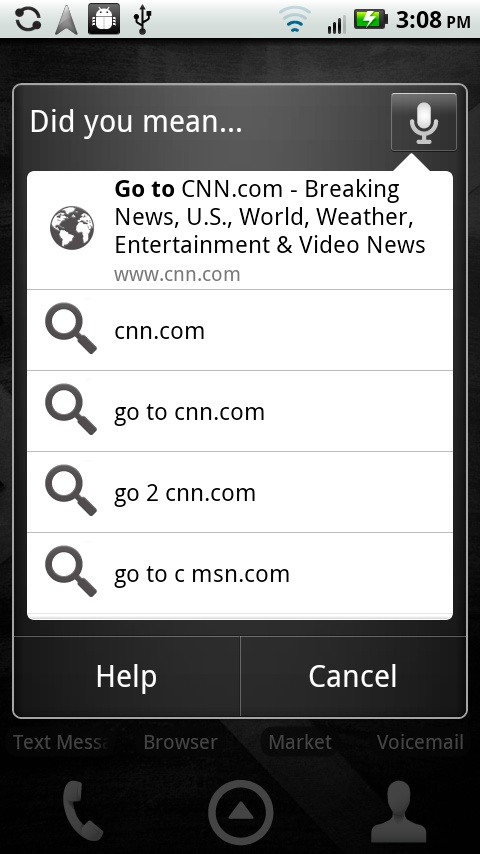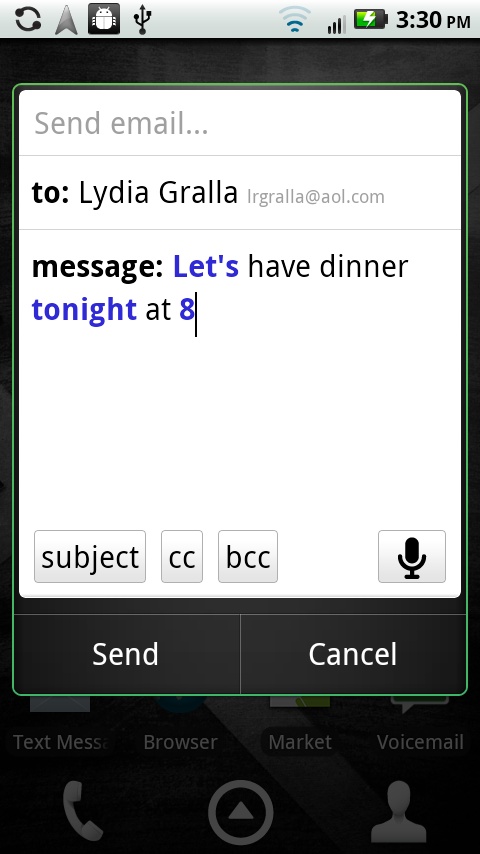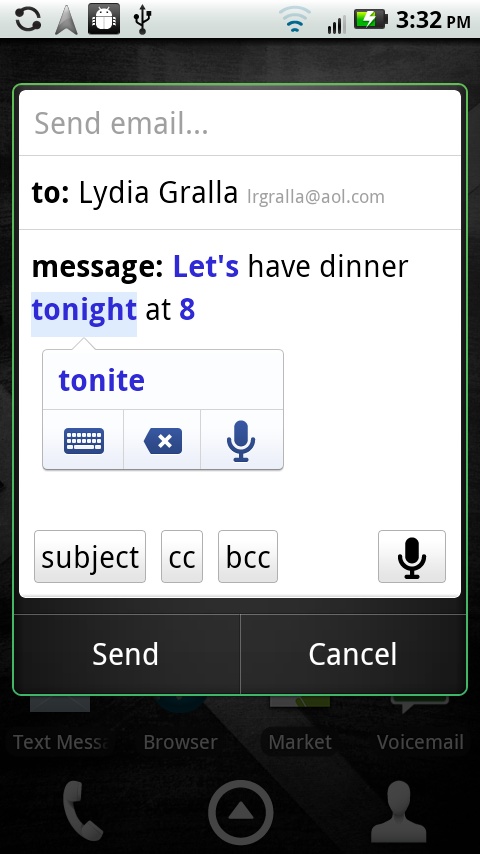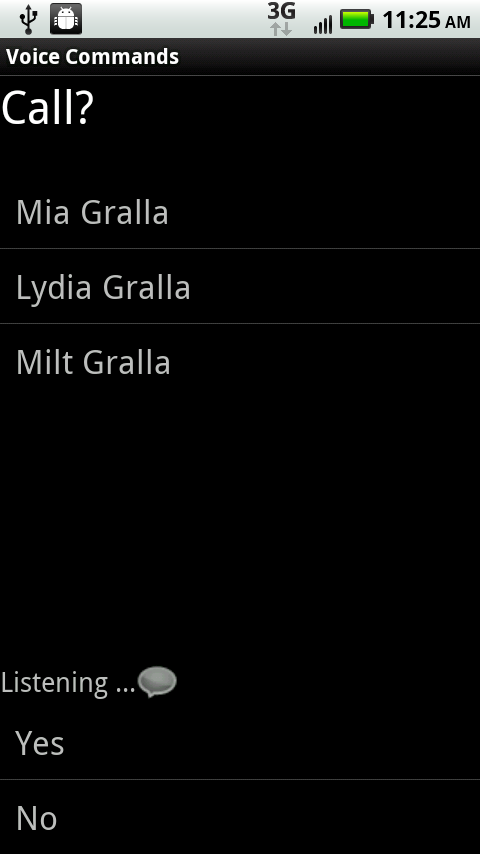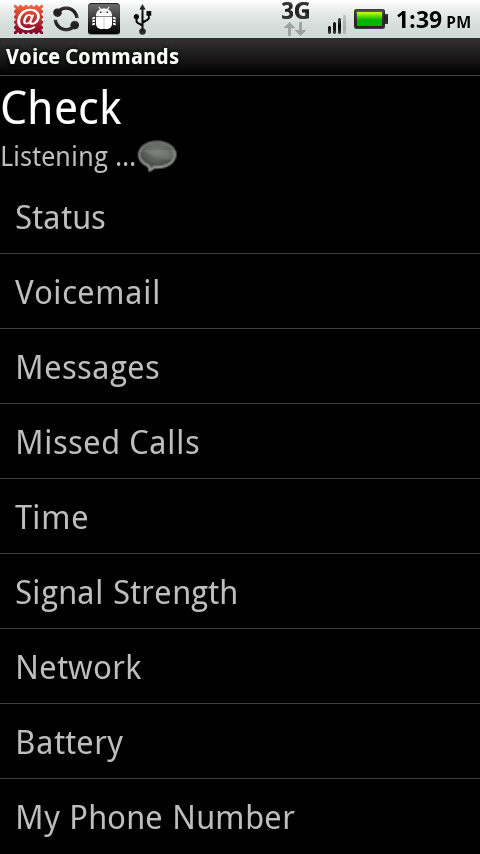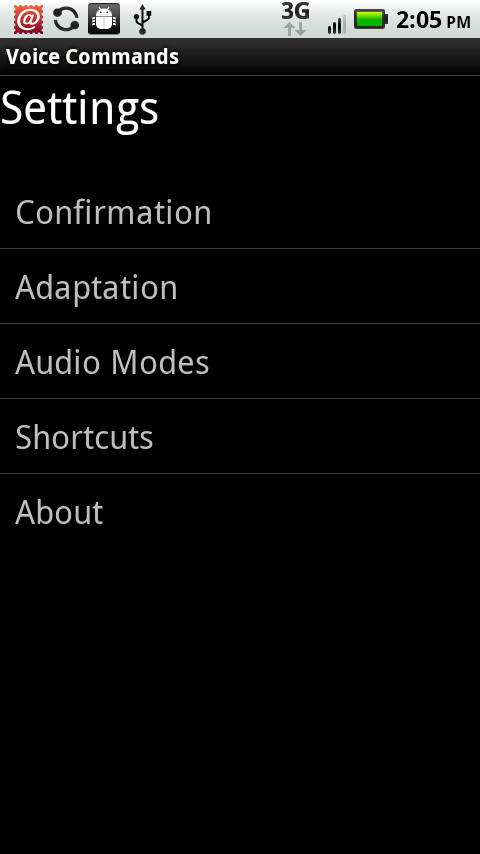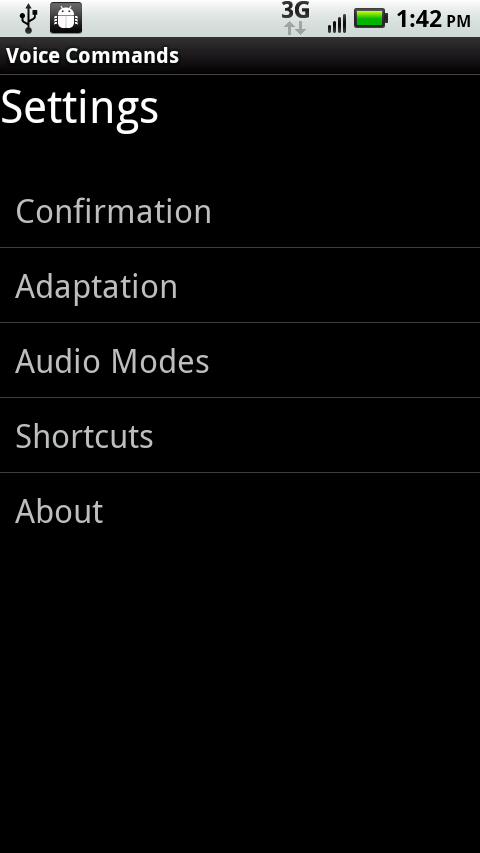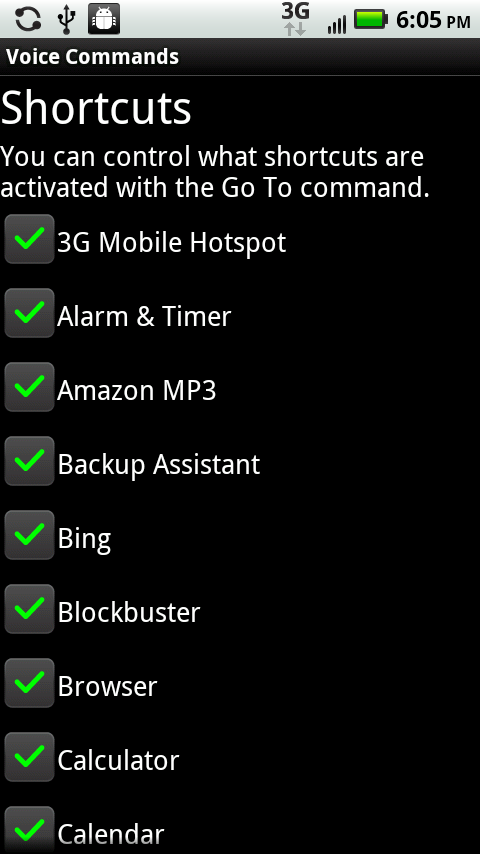Chapter 14. Controlling the Droid X with Your Voice
You’ll spend a lot of time talking into your Droid X when you make phone calls, certainly. But you can do a lot more with your voice as well. Want to send a text messages, get directions to a city or street address, and visit a website? Rather than having your fingers do the walking, have your voice do the talking, and you can do all that and more.
You do all this using an app built into the Droid X called Voice. It’s simple and straightforward, as you’ll see in this chapter. There’s a related voice app that lets you search the Web using your voice, and you’ll learn all about that as well.
Two Ways to Control the Droid X by Voice
You have two ways to control the Droid X with your voice—using Voice Actions and using Voice Commands. Voice Commands are generally more limited than Voice Actions—you can’t, for example, dictate an email or text message using them, or search the Web. However, you can use Voice Commands to do such things as checking your battery status or looking up a contact, which you can’t do with Voice Actions.
Note
You can only use Voice Actions if you have Android Version 2.2 or higher on your Droid X. To make sure, when you’re at the Home screen or on a pane, press the Menu key, and then select Settings→About Phone, and look under “Android version”. If it’s 2.2 or greater, you’re set. If not, tap System Updates at the top of your screen, and the Droid X should download and install the newest version of the operating system.
You’ll use Voice Actions more than Voice Commands, but you’ll likely want to try both.
Using the Magic of Voice Actions
Possibly the most amazing part of Droid X’s amazing Voice Actions feature is this: The only thing you really need to know about it is how to talk. Your voice is its command.
Launch it in one of three ways:
Note
The Voice icon shows up wherever the Google search box does, either when you’re visiting Google on the Web, or in the Google Search Box widget that appears on the Social Networking pane.
Another amazing thing about the Voice Actions feature is that it seamlessly uses two different speech technologies to do what you tell it to: voice recognition and speech-to-text. With voice recognition, it recognizes the action you want to take and then accomplishes the action: “Send text” or “Navigate to,” for example.
With speech-to-text, it translates your words into written text and, for example, embeds that text in an email or text message. Say you tell your Droid X: “Send text to Ernest Hemingway. Consider using young woman and the sea as title because demographics are better.” Your Droid X will find Ernest Hemingway’s contact information and then send him the text message “Consider using young woman and the sea as title because demographics are better.”
Whichever way you launch Voice Actions, a screen appears with a picture of a microphone and the words “Speak now”. Tell the Droid X what you want it to do, and it displays a “Working” screen to show you that it’s deciphering what you want it to do. Remember, if you’re sending an email or a text message, you can dictate the message itself.
Note
If instead of speaking a command, such as to send an email, you merely say a term, the Droid X will launch a Google search for that term.
Next, the Droid X does what you tell it—for example, composes an email or text message. If you tell it to compose an email or text message, it won’t immediately send it. Instead, it shows you the message, so you can send it, edit it, or cancel it.
What You Can Do with Voice Actions
Here are the commands you can issue with Voice Actions, along with how to use them:
Send text to [recipient] [message]. Composes a text message to the recipient with the message that you dictate.
Send email to [recipient] [subject] [message]. Composes an email message to the recipient with the subject and message that you dictate.
Navigate to [address/city/business name]. Launches the Droid X Navigation app to guide you with turn-by-turn directions to the address, city, or even a specific business.
Call [contact name] [phone type/phone number]. Calls the contact. If the contact has more than one phone number, say the type of phone number to call—for example, home, work, or mobile. Alternatively, you can dictate a phone number, and the Droid X will call that number.
Map of [address] [city]. Launches Google Maps and opens it to the address or city you named.
Directions to [address] [city]. Launches Google Maps and show directions for how to get to the address or city you named. If the Droid X knows your location, it uses that as the starting point. If it doesn’t know your location, you must type it when Google Maps launches.
Listen to [artist/song/album]. Don’t expect this to launch the Music app and play music—that’s not what it does. Instead, it works in concert with a radio app, similar to Pandora, which you can download from the Market. When you speak the instruction, it plays the radio station that you’ve already created for the artist, song, or album. If you haven’t created one, it creates it for you.
Call [business name] [location]. Calls the business you named. If there’s more than one location, say the location. If the Droid X finds more than one phone number for the business, it lists all of them. Just tap the number you want to call.
Go to [website]. Launches your browser to the website you dictated. Often, rather than going straight to the website, it displays a list of sites or searches that matches what you dictated. Tap the one you want to visit.
[Search term]. Simply say your search term, and the Droid X searches the Web using Google.
Note
If you dictate a search term that is also the name of a contact, the Droid X opens the contact, rather than searching the Web.
Editing Text Messages and Email with Voice Actions
Voice Actions does a very good job of converting your speech into text when you dictate an email or text message. But it’s not perfect. So you might be leery of using Voice Actions to dictate a message, worrying that when you dictate, “I love you, too,” the message sent will be, “I move YouTube.”
Not to worry. Before you send a text message or email, you get a chance to edit the text. As explained earlier, the Droid X displays your message first, giving you the opportunity to edit, send, or cancel.
Voice Actions uses its own email and text messaging app, rather than the Droid X’s usual ones. With good reason—Voice Actions knows that it might not be able to recognize every word properly, and its email and texting apps have an editing tool that takes that into account.
When the message is displayed, the app shows in blue any words that it believes it may not have understood. Tap the word, and a list of possible other matching words appears underneath. Tap any matching word to have it replace the original
Three icons also appear—a keyboard, an X, and a microphone ![]() . Tap the keyboard icon, and you can type the word you want to replace the original word. Tap the microphone icon, and you can speak the word again. Tap the X to simply delete the word.
. Tap the keyboard icon, and you can type the word you want to replace the original word. Tap the microphone icon, and you can speak the word again. Tap the X to simply delete the word.
From the editing screen in the email app, you can also edit any part of the message, not just words in blue. You can add a subject, CC, and BCC recipients as well.
Using Voice Commands
Voice Commands is a more limited app than Voice Actions, although it does some of the things that Voice Actions does, like making phone calls. Voice Commands is as easy as talking. Press the Home key twice, and a friendly female voice instructs you to “Say a command,” and the screen displays “Say a command” as well.
Note
You can launch Voice Commands no matter what app you’re using by pressing the Home key twice. You don’t need to be on the Home screen in order to launch it. You can also launch Voice Commands by tapping its icon in the Application Tray.
At this point, tell the Droid X what to do—“Call Carmen Jones,” for example. The Droid X asks you to confirm the action; for example, “Did you say, ‘call Jamie Jones’?” Say yes or no, or tap Yes or No at the bottom of the screen. If you answer No, the Droid X says (and displays onscreen) “Command not recognized. Try again?” If you want to give it another try, say or tap Yes, and repeat what you said. Say or tap No, and, after a brief warning screen, you exit the Voice Commands app.
If the Droid X recognizes what you wanted it to do, at this point, your wish is its command. If you’re making a call, for example, it repeats the phone number to you, show it onscreen, and then make the call. If you tell it to run an app, it tells you and shows you what app it’s about to open, and then opens it.
Note
If you’re making a phone call, speak the phone number to call if the person isn’t in your Contacts list.
Life, though, is rarely so simple. Right out of the box, Voice Commands isn’t a great listener, and doesn’t always understand what you say. It does a good job of recognizing the task you want it to perform, such as making a phone call or opening an app, but it isn’t nearly as good as recognizing names—or it may be confused when several names in your Contacts are similar. If it can’t completely understand you, it pops up a list of possibly choices, for example, a set of names. Say or tap the name you want to call. Although, as a practical matter, if Voice Commands didn’t understand you the first time, it probably won’t understand you the second time, either. At this point, tapping is probably better than speaking.
If you’re a glutton for punishment, or have plenty of time to spare, don’t do anything, and the Droid X reads you each of the choices onscreen in turn. After each choice, say no if it’s wrong; say yes when you get to the right choice. If none are the right choice, start all over again.
Note
The Droid X’s voice-synthesis capabilities are a lot like most voice synthesis capabilities—that is to say, fairly rotten. It does a good job of pronouncing words it already knows, and often a very bad job of pronouncing words it doesn’t know. It’s particularly bad at pronouncing names. So when controlling the Droid X with your voice, you’ll often have to look at the screen, because you may not understand what it’s asking you.
If you’ve asked the Droid X to make a phone call or send a text message, email, or so on to a contact and the contact has multiple phone numbers or email addresses, a list of them appears onscreen. Tap or the number or address you want to use. The next time you take that action for that contact, the Droid X won’t bother with asking which phone number or address to use—it’ll use that one.
What Can You Control with Your Voice?
You can tell the Droid X to do much more than just make a call or send an email. After you launch Voice Commands, wait a second or two, and it will display the entire list of its commands. Tap any to have it perform that command. So, for example, if you select Call, the Droid X will ask what person or number it should call. Here are some other things you can do:
Call <Name or #>. As discussed on Placing a Phone Call, this command makes a phone call.
Send Text <Name or #>. This command opens a new text message.
Send Picture <Name or #>. Say this phrase, and you’re supposed to be able to send a picture via email or text messaging. In reality, though, the Droid X doesn’t really follow through. Instead, it just opens a new email or text message addressed to the person. You then have to insert the picture from inside that app. So if you want to send a picture to someone, this command is no faster than Send Email.
Send Video <Name or #>. Just like the Send Picture option, this command doesn’t actually send a video. Instead, it opens the email or text messaging app for you. You have to do the rest.
Send Email <Name or #>. Opens your Email app and addresses a message to the person.
Lookup <Name>. Looks up and displays contact information.
Go to <Menu>. Say the name of an app, and Voice Commands launches it. It’s not clear why this item lists <Menu> as the category of word you’re supposed to speak, because it opens apps, not menu items.
Play <Playlist>. If you’ve got any playlists in the Music app, say “Play” followed by the name of the playlist to play it.
Check <Item>. Here’s a quick way to check the status of a wide variety of items on your phone, such as your voicemail, battery level, and so on. Say “Check” and follow it by one of these words: status, voicemail, messages, missed calls, time, signal strength, network, battery, volume, and my phone number. Most of these are self-explanatory; say “battery,” and Voice Commands reads you and displays your battery level. Say “signal strength,” and it tells you how many bars you have.
When you say “network,” it tells you what mobile network you’re on—either your normal one (home), or the name of another one if you’re roaming. If you say “status,” it reads off and shows every single item on the list!
Training the Droid X to Obey
Right out of the box, the Droid X does a reasonably okay job of understanding your commands. But you can improve its accuracy if you’re willing to spend a few annoying minutes training it.
To do so, when you’re in Voice Commands, press the Menu key and select Settings→Adaption→Adapt Voice. You get a brief warning that you should train the Droid X in a quiet room. After you’ve gone to a quiet room (and you should, because otherwise the training won’t work well), tap Start to begin.
The Droid X asks you to say a series of commands, names, and numbers, such as “Call Don Jacobs Mobile.” If it doesn’t understand you, it asks you to say it again. After about 5 minutes of this, you’re done. It won’t make a massive change in the ability of the Droid X to understand you, but it will improve recognition rates.
Setting Voice Commands Options
You can make slight alterations to the way Voice Commands works. While you’re in Voice Commands press the Menu button and select Settings. Here you can change the following settings:
Confirmation. Sets whether Voice Commands confirms its action before taking it—asking you first whether it should go ahead with your command. You can choose from three settings: Automatic (which is what it’s normally set to), Always Confirm, and Never Confirm. With the Automatic setting, the Droid X takes the action if it’s reasonably sure that’s what you want to do; otherwise it asks for confirmation.
Adaption. As discussed in the previous section, this lets you train the Droid X to better recognize your voice.
Audio Modes. Here’s where you set whether the Droid X speaks to you or just displays onscreen messages. You get three settings: Expert mode, Prompt mode, and Readout mode. If you’re a believer in the silence-is-golden theory of Droid X use, select Expert mode, because in that mode, Voice Commands doesn’t speak to you at all. Prompt mode is the normal mode of operation—the Droid X reads you only the important parts of its messages. In Readout mode, it reads everything onscreen. Think of it as chatterbox mode; you likely don’t want to use it unless you’re very, very lonely and pine for the sound of an artificial voice.
Shortcuts. Shows you a list of every app and shortcut you can launch using the Go To command. Every item with a green checkbox next to it will work with the command. Uncheck the box next to any that you don’t ever want to open by voice.

